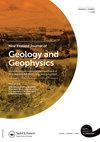新西兰普普克湖全新世古地磁长期变化记录
IF 1.9
4区 地球科学
Q1 GEOLOGY
New Zealand Journal of Geology and Geophysics
Pub Date : 2021-10-11
DOI:10.1080/00288306.2021.1985529
引用次数: 1
摘要
摘要将三个湖泊沉积物核心的古地磁记录合并,为新西兰北部创造了一个新的全新世地磁长期变化记录。岩芯来自奥克兰火山场(AVF)的马尔湖Pupuke湖。它们包含Rangitoto火山的火山灰岩(530 ± 10 年BP),陶(1718年) ± 10 yr BP),图华/马约尔岛(7637 ± 100 yr BP)和来自Ōkataina火山中心的Rotomātephra(9423 ± 120 年BP)。这些tephra日期由选定的放射性碳年龄估计补充。使用tephra和磁化率的精细尺度变化对岩心进行了关联。天然残余磁化强度强、稳定,由AVF玄武岩火山的细粒钛磁铁矿携带。由此产生的古长期变化(PSV)记录跨度从10000到1500 年BP。它显示了明确的千禧一代规模在10000到8000之间的方向波动 年BP介于4000和1500之间 年BP,在8000到4000之间 yr BP变化具有较高的频率和较低的振幅,并且以地心轴向偶极子场方向为中心。这与Mavora Lakes公布的PSV记录非常一致,1000 再往南公里,表明PSV的区域性——这是由地核富含铁的导电流体循环的大范围变化引起的。本文章由计算机程序翻译,如有差异,请以英文原文为准。
A Holocene palaeomagnetic secular variation record from Lake Pupuke, New Zealand
ABSTRACT Palaeomagnetic records from three cores of lake sediment have been merged, producing a new Holocene geomagnetic secular variation record for northern New Zealand. The cores are from Lake Pupuke, a maar lake in Auckland Volcanic Field (AVF). They contain tephra from Rangitoto Volcano (530 ± 10 yr BP), Taupō (1718 ± 10 yr BP), Tūhua/Mayor Island (7637 ± 100 yr BP) and Rotomā tephra from Ōkataina Volcanic Centre (9423 ± 120 yr BP). These tephra dates are supplemented by selected radiocarbon age estimates. The cores were correlated using tephra and fine-scale variations in magnetic susceptibility. The natural remanent magnetisation is strong, stable and carried by fine-grained titanomagnetite from AVF’s basaltic volcanoes. The resulting palaeosecular variation (PSV) record spans from 10,000 to 1500 yr BP. It shows well-defined, millennial-scale swings in direction between 10,000 and 8000 yr BP and between 4000 and 1500 yr BP, while between 8000 and 4000 yr BP variations are of higher frequency and lower amplitude and centre on the geocentric axial dipole field direction. This is in excellent agreement with published PSV records from Mavora Lakes, 1000 km further south, indicating the regional nature of PSV – resulting from broad-scale changes in the circulation of conducting iron-rich fluid of Earth’s outer core.
求助全文
通过发布文献求助,成功后即可免费获取论文全文。
去求助
来源期刊
CiteScore
5.10
自引率
27.30%
发文量
34
审稿时长
>12 weeks
期刊介绍:
Aims: New Zealand is well respected for its growing research activity in the geosciences, particularly in circum-Pacific earth science. The New Zealand Journal of Geology and Geophysics plays an important role in disseminating field-based, experimental, and theoretical research to geoscientists with interests both within and beyond the circum-Pacific. Scope of submissions: The New Zealand Journal of Geology and Geophysics publishes original research papers, review papers, short communications and letters. We welcome submissions on all aspects of the earth sciences relevant to New Zealand, the Pacific Rim, and Antarctica. The subject matter includes geology, geophysics, physical geography and pedology.

 求助内容:
求助内容: 应助结果提醒方式:
应助结果提醒方式:


